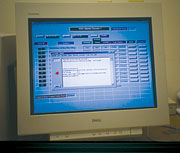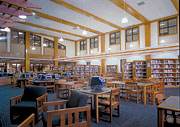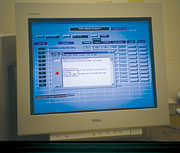
Noble High School is one of Maine's largest public schools, designed not only to educate 1,500 students, but also to serve as the community center of three small towns. Besides 85 classrooms and related support spaces, the 270,000-sq-ft building has a community health care clinic, a day care center, an adult education center, a restaurant, and one of the largest performing arts centers in the region. The diverse uses mandated special consideration in the design of the HVAC systems. And with Maine's long, cold winters, energy efficiency and comfort took on even more importance than they might in other regions.
The school is located in North Berwick and is part of School Administrative District #60, which covers the towns of Berwick, North Berwick, and Lebanon, rural communities with a combined population of about 15,000. The area experienced such growth in recent years that its 1,000 high school students were crammed into a building meant for 600, and overflowing into 14 trailers. Besides needing more space for educating its youngsters, town residents wanted a new building that could also function as the hub of the three towns.
The new, $33.9 million facility, which meets those goals, was completed in September 2001, designed by Harriman Associates of Auburn and Portland, Maine, a full-service firm that provided both architecture and engineering services. The school's teaching methods put a priority on collaboration and interaction among students, and there is intensive community use, more than in most schools. Finding ways to balance the need for occupant comfort with the needs for energy efficiency and system flexibility was a necessity.

Managing energy use
A temperature control and EMS from Invensys (formerly Siebe) provides the means for regulating which parts of the building are heated, ventilated, and air conditioned at various times. The DDC system is programmed from a central computer, giving the school flexibility to deal with uses of the building outside school hours and to lower temperatures throughout the building at night. The system has individual zone control for each room. It also provides a way for school officials to track energy use trends and to make modifications in system operation for greater savings."The temperature control system we have here at Noble is truly remarkable," said Kevin Moore, maintenance supervisor. "It allows us to be energy efficient, while maintaining quality comfort." The thermostats in all classrooms can be adjusted only at the graphical user interface (GUI), which is located in the custodian's office. Giving the maintenance staff sole source control of temperature setpoints eliminates potential wasting of energy when thermostats are turned all the way up by occupants. In addition, the system automatically lowers nighttime temperatures to 60 degrees F for energy savings, although a teacher who might want to work during unoccupied times can override the setback for two hours with the push of a button on the thermostat.
The GUI makes the system easy to operate without needing experience in programming and computers. With minimal training by the controls contractor, the building's maintenance staff is able to utilize the system features. With a few clicks of a mouse, the operator can change the thermostat setpoint temperatures in individual rooms and can change the times at which individual air-handling systems in the building are placed in the "occupied" or "unoccupied" mode. This allows the maintenance staff to override and change preprogrammed schedules. "Although the system is high-tech, it is very easy to learn and understand. It basically runs itself," Moore said. "It still amazes me that with the click of the mouse, I can change the building atmosphere to accommodate everyone's needs," he added.
The GUI was custom-made for Noble by Maine Controls, the local representative for Invensys, and Harriman Associates specified that 10, four-hour training sessions be part of the package instead of the four or five usually specified for a smaller school. A modem connects Noble's system with Maine Controls' office, allowing data to be sent to the company for an analysis of problems, often eliminating the need for a visit by a technician. If the problem cannot be solved, the data transmitted still gives the technician valuable information that could shorten his visit. "As with any system, problems do occur. But since the system is monitored by the company that installed it, I have someone to fall back on if a problem arises that I can't solve," Moore said.
Boilers and fans
The staged operation of two, 4,000-MBtuh oil-fired boilers made by Bryant is another method for energy savings. A system from Century Controls determines whether one or both boilers are needed, based on the temperature difference between supply and return water as well as the temperature of the outside air. The system modulates the firing of the burners, allowing a gradual increase to full output as well as a gradual decrease during shutdown. Gradual modulation and staging of the boilers is the most efficient method of operation.It is anticipated that the system will result in a 3% to 5% annual savings in fuel, or about 2,000 to 3,500 gallons, and will have a three- to five-year payback, according to the distributor, Atkinson & Lawrence Inc., of Massachusetts. The boilers have also been furnished with combination gas/oil burners, to give the owner the flexibility to use natural or LP gas as a fuel source at a later date.
In the kitchen, pressurization controls add to energy efficiency. The kitchen has four exhaust hoods, displacing 7,500 cfm, 5,000 cfm, 1,500 cfm, and 1,200 cfm, respectively. Each is switched on manually as needed. To ensure that the proper amount of makeup air is supplied to the space, a differential pressure controller compares the pressure in the kitchen to that of the adjacent "town square" in the building. When fans are turned on, the pressure in the kitchen becomes more negative, compared to that of the adjacent space, and dampers in the AHU slowly bring in more outside air. Conversely, if the difference indicates more positive pressure in the kitchen, outdoor air intake is decreased.
In the industrial arts wood shop, a recirculation system "vacuums" sawdust and other particulates from the woodshop equipment and returns cleansed air to the space. The collection system, manufactured by Aget, is manually controlled and has a 4,100-cfm fan that draws dust-laden air from the shop through a cyclone separator and a filter before sending it back to the space.
By reducing the need for makeup air from the outside, energy efficiency is enhanced. Without this recirculation air system, unheated air would be drawn in from cracks in windows or doors, or a makeup air system would have to be provided to heat outside air and introduce it to the space to compensate for the exhausted air.

Chasing chills
The use of radiators on perimeter walls adds to the comfort of building users in winter, taking care of the heat loss that occurs to the building envelope and augmenting the heated air supplied through ducts from the air-handling system. In classrooms with wood casework along the outside walls, radiators were installed behind the casework, grilles were installed in the top of the casework and slots were cut into the kickspace areas, to allow for air convection. The radiators also enhance energy efficiency since they can be used to keep the building warm at night, rather than using the air-handling systems.But radiators could not be installed in science rooms because the architect did not want cuts to be made in lab counters. Instead, fan-powered VAV boxes act as mini AHUs during unoccupied times. When a thermostat indicates the need for added warmth, a fan disperses heat generated by a coil in the box. The fan unit uses only a l/3-hp motor, compared to the 30-hp motor which would have to be switched on if the AHU that serves the science rooms as well as 50 other classrooms had to be activated. This is a special asset for the low levels of nighttime heating needed.
Comfort was a special concern in the child care center. In addition to heat supplied through ducts, the room has thermostatically controlled radiant floor heating, since young children often sit or crawl on the floor and take naps there. In addition to responding to a room temperature sensor, the radiant floor heating system also has a floor sensor that does not allow the floor temperature to drop below 70 degrees.
Keeping cool
While keeping chills away is the goal during winter, fall, and spring, Maine can be hot in the summer, so some parts of the building are air conditioned - the adult education wing, the administration and reception area, the library, classrooms used for summer school, the auditorium, the audio-visual studio, computer classrooms, the community clinic, and the large lecture hall.
The system is designed with an economizer cooling cycle that is particularly useful in spring and fall, when outside temperatures are cool, and inside temperatures rise due to heat build-up from people, lighting, and equipment. Rather than mechanically conditioning the air with the A/C units, the system can operate dampers that gradually bring in the cooler, "free" outside air, offering significant energy savings. The system is an "enthalpy" economizer system, which means that it will not allow large quantities of outdoor air to be brought into the building if the outdoor air has a high moisture content with respect to the indoor air. The system is controlled by the Invensys energy management system. Up to 100% outside air can be brought in through every air handler.
Shutdown insurance
Generators and environmental alarms are also tied into the Invensys EMS. With frigid temperatures a given in Maine, generators to keep systems operating during power outages were deemed mandatory for essential components such as the heating water pumps and the boilers. In addition, the Invensys system is programmed to send a signal to the building security system should failures occur. The system, in turn, generates a phone call that alerts a designated person who can then go to the school to investigate the problem.
The system also provides a "trend log" that helps operators diagnose a problem or a complaint about a specific room. The position of controls such as the outside damper and heating valves is recorded every 10 minutes. The log is a timesaver for diagnostics and problem solving.

A quiet auditorium
Since Noble High School's 1,000-seat auditorium is one of the largest performing arts spaces in the region, it was planned with the high-quality lighting and sound systems that could accommodate professional performances, and equal attention was given to acoustics that would not distract an audience and interfere with a performance.
Working with consultants at Accentech, engineers designed a system with oversized ducts, which move 21,000 cfm of air at relatively low velocities, thus reducing noise. In addition, all the ducts were completely acoustically treated, not just the usual 15 ft out from the unit. Sound attenuators were also provided in the supply and return duct mains. The result is a system that provides the right levels of comfort for occupants, but that has been also been praised for its lack of noise.
A milk of magnesia solution
The school's EMS also helps control a problem with wastewater. Noble High School's sanitary waste line connects to the public sewerage line about 2 miles away, and that presented a sensitive disposal problem. The length of the pipe meant that wastewater could have an undesirable odor by the time it reached the connection, due to the proliferation of anaerobic bacteria.
Engineers solved the problem by creating a mini-wastewater treatment system at the school. Waste goes into a 10-ft diameter by 20-ft deep holding tank. Compressed air is blown into the tank, making the environment less hospitable to anaerobic bacteria. And industrial-grade milk of magnesia is injected into the mix, destroying anaerobic bacteria, but not the aerobic bacteria needed for proper decomposition. Sensors connected to the Invensys EMS control the injection rate of the milk of magnesia solution as well as the flow of compressed air into the tank and the staging of the two sewage ejector pumps. The waste, with tolerable odor levels, is then pumped into the pipes to the public sewerage line.
Heading off problems
Getting the most from an HVAC system is important for an organization, but especially so for schools, where budgets are tight. System longevity and easy maintenance are priorities, so that more money can be used for education, not facility issues.At Noble, locating the AHUs inside the building will shield them from Maine's harsh climate and is expected to double usable service time. Outdoor units typically last just 10 to 15 years, while indoor units last 30 to 50 years. Indoors, the housings of the units will remain in good condition, and only moving parts will have to be replaced.
In addition, the complexity of today's HVAC systems make commissioning a prudent practice. At Noble, all of the building's HVAC systems were commissioned to verify that all components were installed and operating efficiently in accordance with the design intent. Approximately 500 deficiencies were discovered and remedied during the commissioning process. Without commissioning, many of these deficiencies would have gone undetected and would have plagued the owner with maintenance and service issues for years to come.
With its diverse systems and focus on efficiency, the HVAC systems at Noble High School are on track to provide years of comfort for occupants and easy maintenance for owners. ES
